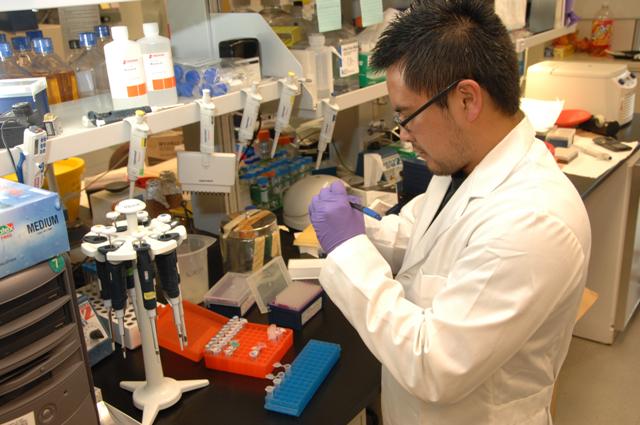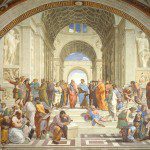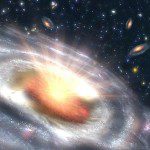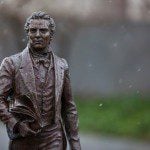
(Wikimedia Commons public domain image)
First of all, I wish a happy fourth of July to everybody out there and a Happy Independence Day to my fellow yanquis, and, to my English friends, I offer this chirpy little ditty from no less a personage than King George III himself.
And now, that done, I want to share a few passages from Michael Guillen, Believing is Seeing: A Physicist Explains How Science Shattered His Atheism and Revealed the Necessity of Faith (Carol Stream, IL: Tyndale Refresh, 2021). Dr. Guillen, who grew up in East Los Angeles (not too terribly far from where I myself was raised, although he’s a few years younger) before studying mathematics, physics, and astronomy at UCLA and Cornell, taught physics for eight years at Harvard University before becoming the chief science editor for ABC News:
In Discourse on the Method of Rightly Conducting the Reason and Seeking the Truth in the Sciences, René Descartes — the seventeenth-century French philosopher and co-formulator of the SM [scientific method] — describes the scientific method as consisting of four basic rules:
- Be open-minded: Approach science without any preconceptions or prejudices. Accept as true only those things that reliable experiments reveal to you.
- Be systematic: Tackle the simplest mysteries first. Then systematically work your way up to the most vexing ones.
- Be analytical: Break down every complex phenomenon to its simplest elements. Then, one by one, study each element.
- Be exhaustive: When doing an experiment, take into consideration every relevant variable. Leave no stone unturned.
Descartes’s four-step SM sounds quite reasonable. Yet search online for “scientific method,” and you’ll be served up scores of authoritative-looking websites explaining that the SM has five, six, seven, eight, or more steps — or even that it has no hard-and-fast steps at all.
Also, you’ll find that the SM varies by discipline. Astronomy is done differently than biology is done differently than zoology, and so forth. Lab experiments, which happen in controlled environments, are done differently than field experiments, where variables are difficult to control.
Percy Bridgeman, the Harvard-trained physicist and Nobel laureate, summed it up rather bluntly: “It seems to me that there is a good deal of ballyhoo about scientific method,” he said. “Science is what scientists do, and there are as many scientific methods as there are individual scientists.” (90-91, bolding in the original)
Non-scientist though I am, I couldn’t agree more. It seems obvious to me that there is no single Scientific Method, engraved somewhere in stone. Inquiry in a chemistry lab is quite a different thing — and not merely because of the obvious difference in subject matter — than astronomical inquiry using a telescope or geological inquiry clambering down into the Grand Canyon with a pickaxe. Smashing subatomic particles with a massive accelerator is a distinct method of investigation from counting caribou in the Canadian Rockies.
Dr. Guillen cites the eminent comparative religionist Huston Smith (1919-2016) to make another important point, as well, though Dr. Smith (whom I came to know and to hold in high affection during a summer spent with him in a small seminar in Berkeley many years ago) refers to a singular “scientific method”:
The scientific method is nearly perfect for understanding the physical aspects of our life. . . . But it is a radically limited viewfinder in its inability to offer values, morals and meanings that are at the center of our lives. (97)
And then there is this important implicit caveat from Dr. Guillen:
Scientists in every discipline are now far, far removed from the reality they claim to explain.
Paleontologists routinely draw extravagant, global conclusions about an entire species, based on the study of a single jawbone from a single individual dug up at a single location.
Astronomers make excited claims about the possibility of extraterrestrial life, based on exoplanets they cannot actually see but believe exist based on ever-so-subtle variations in the orbits and brightnesses of stars quadrillions of miles away.
Psychologists come to lavish conclusions about human nature and all people — young, old, rich, poor, rural, urban, educated, uneducated, black, brown, and white — based on studies primarily of white, college-age, paid volunteers. (98)
But there’s more:
Designing an experiment begins with identifying some relatively simple part of a complex phenomenon — one that can realistically be measured.
Take Earth’s climate, for example. It’s a very, very complicated affair, with countless moving parts. To make sense of it, we must start by thinking small and simple — like measuring air temperature or sea levels or solar insolation (the amount of sunlight striking the ground) or cosmic radiation (yes, cosmic rays do affect the climate).
After deciding what to measure, we must figure out how to do it. Measuring air temperature sounds easy enough, but it isn’t. Do we use an old-fashioned mercury thermometer? A digital thermometer? An infrared thermometer?
And where do we make the measurements? Near asphalt, which heats up easily? Near water, which stays cool? On the ground? From space? You get the idea — there’s nothing simple about designing even an experiment as seemingly straightforward as measuring temperature.
It’s no wonder, then, that so many scientists get it wrong.
A team of investigators led by Malcolm Macleod, a neuroscientist at the University of Edinburgh, evaluated the design of 2,671 experiments that involved testing promising new drugs on animals. These studies have life-and-death consequences for human patients worldwide.
Macleod’s team found that the vast majority of these experiments failed — failed — in four key design areas: sample size, randomization, blinding (making sure neither scientist nor subject knows who’s getting what), and conflicts of interest.
When the team focused on only those experiments done in the United Kingdom, the results were even worse. “It is sobering that of over 1,000 publications from leading UK institutions, over two-thirds did not report even one of [the] four items considered critical to reducing the risk of bias, and only one publication reported all four measures.” (98-99, emphasis in the original)
Please note that, in citing Michael Guillen to this effect, I’m not attacking Science™ or scientists. I’m merely passing on a fact that should be obvious — that science, like other academic fields, isn’t infallible, and that scientists are actually human beings, prone to error, pride, bias, blindness, overenthusiasm, prejudice, distracting ambition, dogmatism, and all the other factors that led Puck to observe to Oberon, “Lord, what fools these mortals be!” (William Shakespeare, A Midsummer Night’s Dream, III.2.117).
The prestigious British journal Nature conducted a survey of 1,576 scientists and discovered that “more than 70 percent of researchers have tried and failed to reproduce another scientist’s experiments [one or more times], and more than half have failed to reproduce their own experiments.”
This colossal failure — now called the reproducibility crisis — afflicts research published in the world’s most respected, peer-reviewed journals. (100, italics in the original)
And then, of course, there is the old temptation of dishonesty, to which scientists are presumably just about as vulnerable as are ordinary mortals. There is, so far as I’m aware, no evidence suggesting that bad character never surfaces among those in scientific careers:
A study by Italian scientist Daniele Fanelli discovered that an alarming 72 percent of scientists knew of colleagues who had resorted to “questionable research practices.” And 14 percent knew of colleagues who had outright falsified data.
Worse still, these results were based on self-reporting. So “it appears likely,” Fanelli says, “that this is a conservative estimate of the true prevalence of scientific misconduct.”













